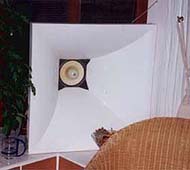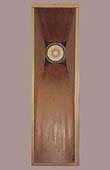Oris Horn History
After building many loudspeaker systems it was clear to me that the only way to create the sound I looked for is to use front horns. Not to be able to play loud but to have true dynamics and dispersion control creating reality and not just a fuzzy reflection of the concert hall!


After experimenting with several front horn principles, which were great experiments, I finally decided to go for a round horn following a specific curve to sound as natural as possible with a size big enough to have a nice low Fg to catch most important bandwidth crossing as low in frequency as possible.
Building a round horn isn't really that easy if you do not have the right tools though. Especially if we need to make an equal pair of them. Having this outsourced will cost a lot of money which has to be paid, choosing the type of the material and related thicknesses were another problems to solve...
Having a lot of experiences with plastics in the past and knowing that plastic is quite dead (acoustically) if designed properly I almost knew for sure that a round and curved shape with variable thickness would give the desired strength and dividing the resonances...
After thorough searching I finally found a factory able to produce the horns I had in mind using A.B.S. (Acrylnitril-Butadien-Styrol) material, which has a very neutral resonance behavior and for a reasonable price. A mold for the horns will guarantee equal products with narrow tolerances but the costs for this is rather high...
What the heck, I want those round horns!
It took about 2 months (the longest months of my life!) before I received my first pair of the round horns, the Oris 150 was born....

...and the looks were great, I couldn't take my eyes of them for several hours!
Okay, time to assemble and complete the horns with Lowther PM2A's which were waiting all that time for a good horn just the same.
Of course I was wondering if they would sound like predicted and connected them quickly to my already warmed up SE-amp...................................YES!!
The Oris 150's gave the warmth, body and fullness in sound which the Lowther PM2A's were missing so badly all that time, not anymore! Even without bass system these babies were sounding pretty good already...
Still, I needed a bass system that should blend well with the Oris horns. The first design used was an Onken-like reflex (aperiodic dampened) system with acceptable dimensions. Later the LaScala to get more dynamic bass but at cost of less deeper frequencies (compromises, compromises....).
Although, I did manage to design a new bass system using custom build 15"bass drivers providing deep, controlled and dynamic bass (i.e. the Reference Compact) and later the Reference Ultra based on this basic design with additional horn (modified Oris 150) mounted in front of the bass driver which shows the least compromise in speed, dynamics and deep bass.
In the mean time the Oris 250 series were added and the Orphean....and more because designing and optimizing our systems for the better is still our hobby!